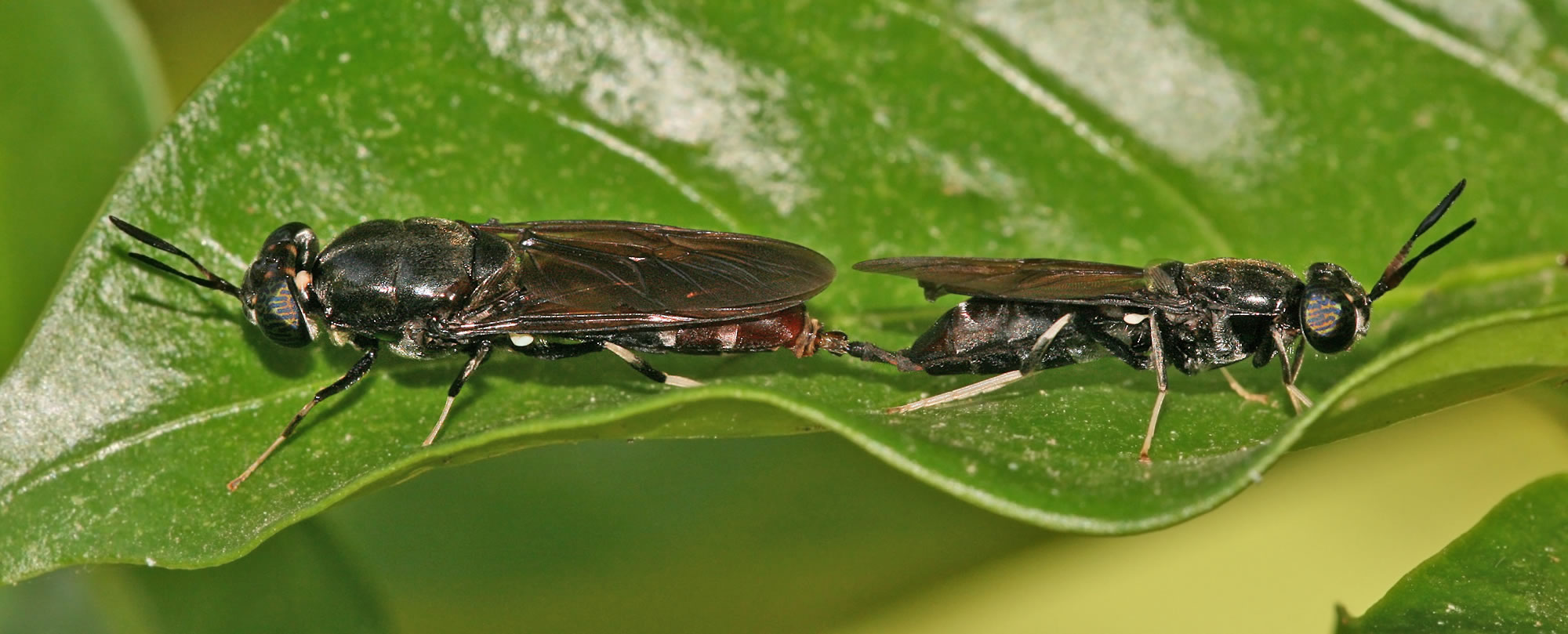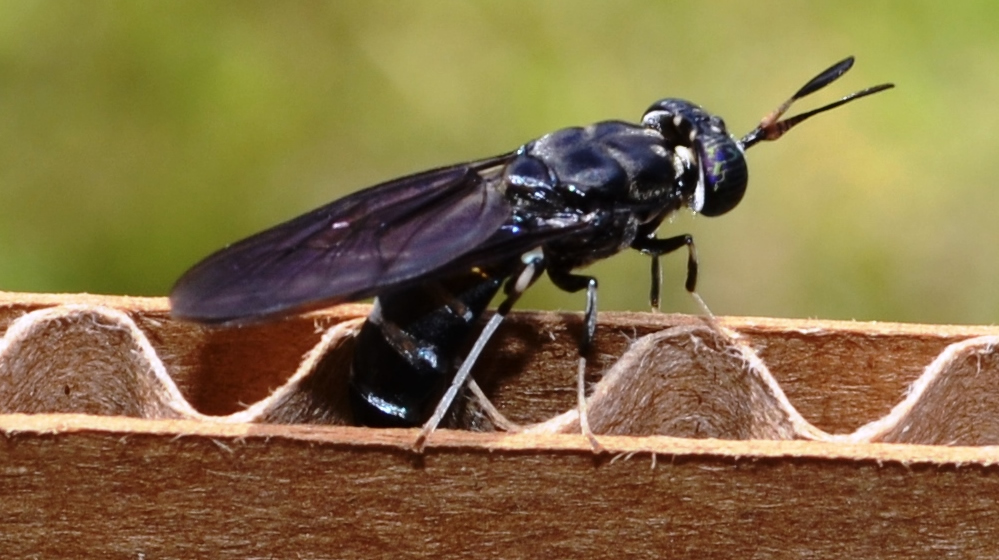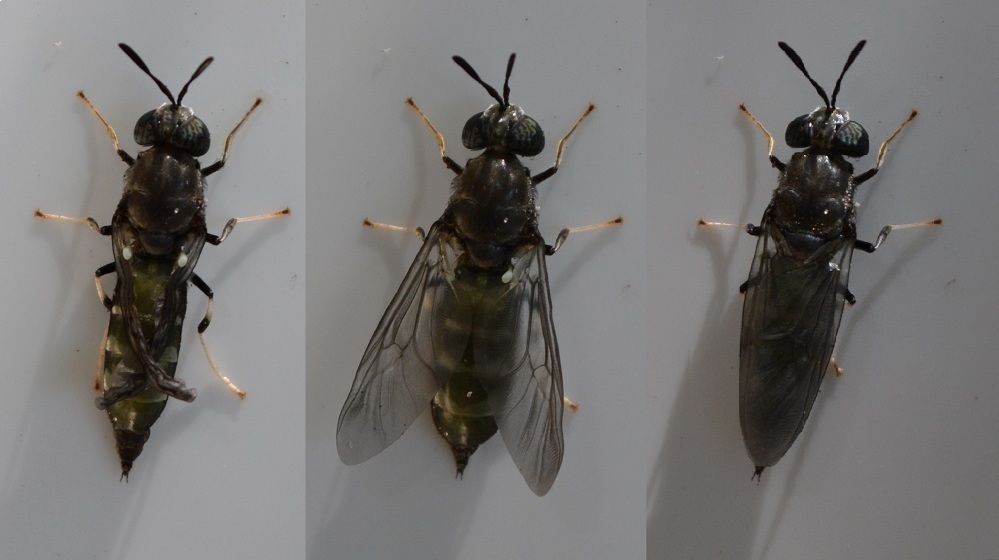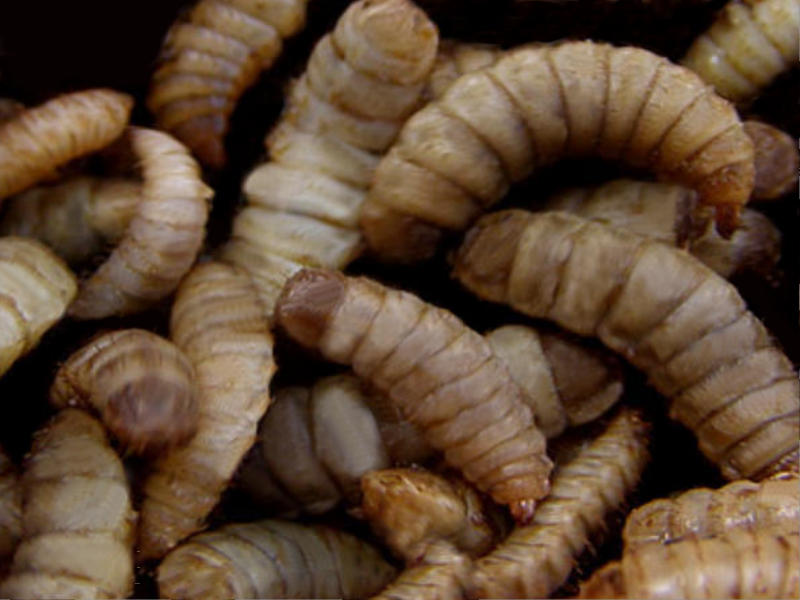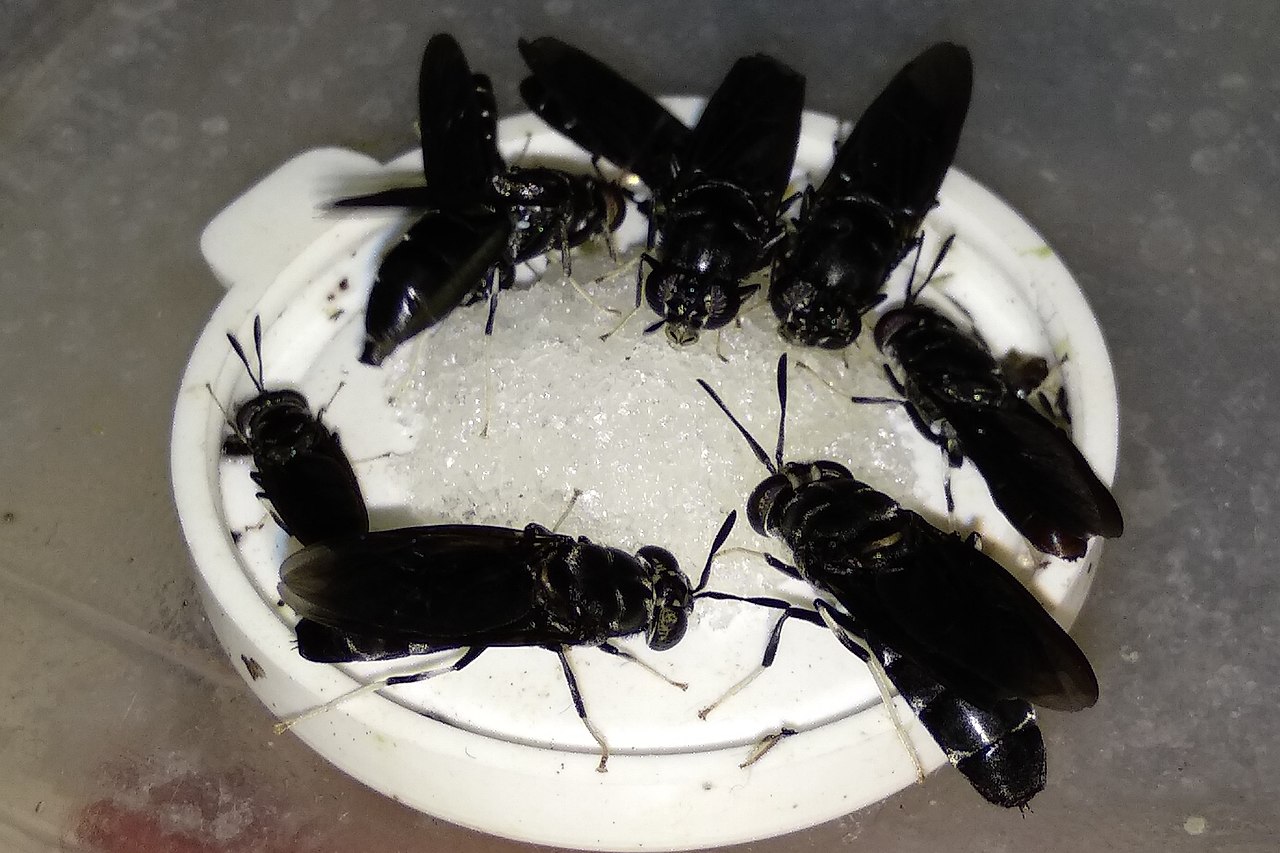Hermetia Illucens (The Black Soldier Fly)
Hermetia Illucens
(The Black Soldier Fly)
Hermetia Illucens, the black soldier fly, is a common and widespread fly of the family Stratiomyidae.
Human Relevance
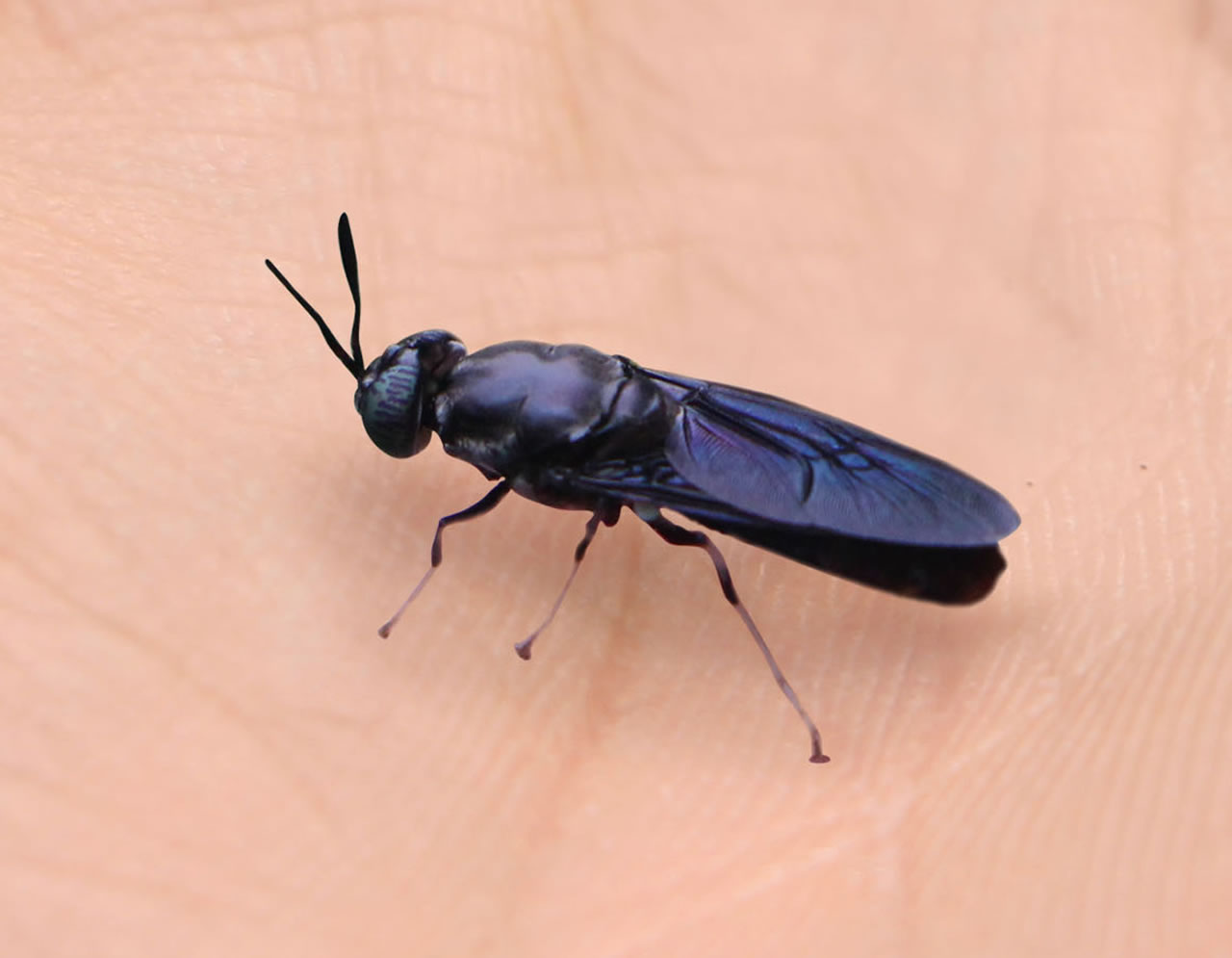

The larvae and adults are considered neither pests nor vectors. Instead, black soldier fly larvae play a similar role to that of redworms as essential decomposers in breaking down organic substrates and returning nutrients to the soil.
Black soldier fly larvae (BSFL) are an excellent source of sustainable protein for aquaculture, animal feed, and pet and human nutrition. The larvae have voracious appetites and can be used for composting household food scraps and agricultural waste products.
Distribution
This species is native to the Neotropical ecozone, but in recent decades has spread across all continents, becoming virtually cosmopolitan. It is present in most of Europe, including the Iberian Peninsula, southern France, Italy, Croatia, Malta, the Canary Islands, and Switzerland. It can also be found in the Afrotropical ecozone, the Australasian ecozone, the East Palaearctic ecozone, the Nearctic ecozone, North Africa, and the Oriental ecozone.
Description
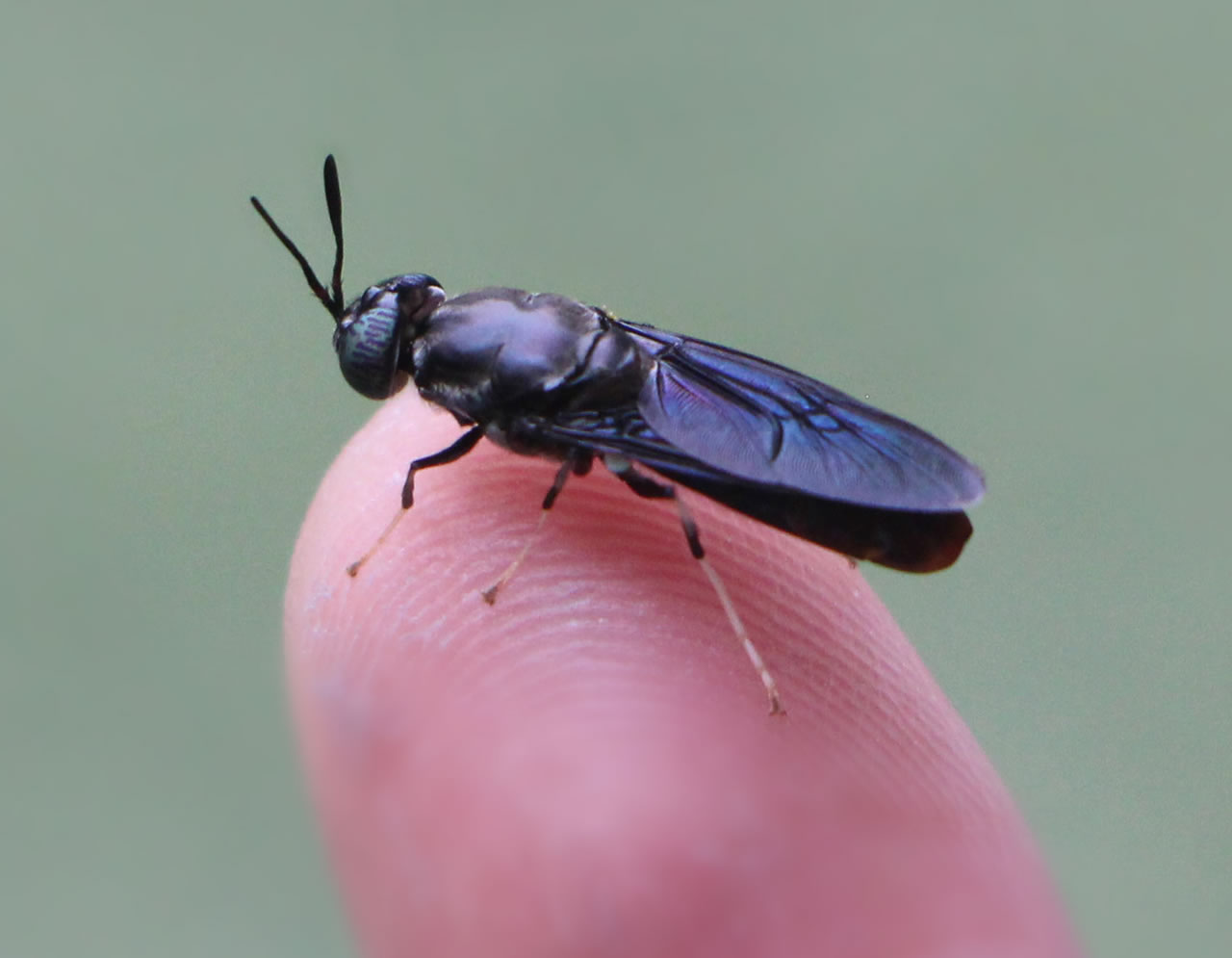

The adults of H. illucens measure about 16 mm (5/8 inch) long. These medium-sized flies have a predominantly black body, with metallic reflections ranging from blue to green on the thorax and sometimes with a reddish end of the abdomen. The second abdominal tergite has translucent areas, from which the specific Latin epithet derives. The head is wide, with very developed eyes. The antennae are about twice the length of the head. The legs are black with whitish tarsi. The wings are membranous; in the resting time, they are folded horizontally on the abdomen and overlapped.
H. illucens is a mimic fly, very close in size, color, and appearance to the organ pipe mud dauber wasp and its relatives. The mimicry of this particular kind of wasp is especially enhanced in that the fly's antennae are elongated and wasp-like, the fly's hind tarsi are pale, as are the wasp's, and the fly has two small transparent "windows" in the basal abdominal segments that make the fly appear to have a narrow "wasp waist". Black soldier fly larvae can be differentiated from blowfly or housefly larvae by a thin gray-black stripe on their posterior ends.
Lifecycle
An adult female lays between 206 and 639 eggs at a time. These eggs are typically deposited in crevices or on surfaces above or adjacent to decaying matter such as manure or compost and hatch in about 4 days. Freshly emerged larvae are 0.04 inch (1 mm) long, being able to reach a length of 1 inch (27 mm) and weight of 0.10 to 0.22 g by the end of larval stage. The larval stage last about 22 days, of which the postfeeding (prepupal) stage lasts around 7 days. The length of larval stage can be delayed by months due to low temperature or lack of food. The pupal stage lasts from 1 to 2 weeks. Adults can live typically 4 to 7 days when provided with water and food such as sugar in captivity or nectar in the wild, or survive for about 8 to 10 days on fat reserves gathered during larval stage when water is provided.
Uses in composting or as food for animals
Black soldier fly larvae (BSFL) are used to compost waste or convert the waste into animal feed. The harvested pupae and prepupae are eaten by poultry, fish, pigs, lizards, turtles, and even dogs. The wastes include fresh manure and food wastes of both animal and vegetable origin.
At the pupal stage, black soldier flies are at their nutritional peak. They can be stored at room temperature for several weeks, and their longest shelf life is achieved at 50–60 °F (10–16 °C).
Fly larvae are among the most efficient animals at converting feed into biomass. Aside from the protein production, fly larvae also produce another valuable resource called frass. Fly larval frass is a granulated and odorless residue that can be used as organic fertilizer.
Grub composting bins use self-harvesting
When the larvae have completed their larval development through six instars, they enter a stage called the "prepupa" wherein they cease to eat and empty their guts, their mouth parts change to an appendage that aids climbing, and they seek a humid, sheltered area to pupate. This prepupal migration instinct is used by grub composting bins to self-harvest the mature larvae. These containers have ramps or holes on the sides to allow the prepupae to climb out of the composter and drop into a collection area.
Benefits
Larvae are beneficial in these ways:
- Their large size relative to houseflies and blowflies allows them to prevent houseflies and blowflies from laying eggs in decaying matter by consuming larvae of other species. This matters because compost systems inhabited by houseflies and blowflies carry a much greater stench than systems inhabited by BSFL, making H. illucens a more human-friendly way to minimize food waste.
- They are not a pest to humans. Unlike houseflies, adult black soldier flies have greatly-reduced sponging mouthparts and can only consume liquids such as flower nectar or do not eat at all. They do not regurgitate food along with digestive enzymes like houseflies, thus do not spread diseases.
- They are not attracted to human habitation or foods. As a detritivore and coprovore, the egg-bearing females are attracted to rotting food or manure.
- Black soldier flies do not fly around as much as houseflies. They have less expendable energy due to their limited ability to consume food as adults. They are very easy to catch and relocate when they get inside a house, as they do not avoid being picked up, they are sanitary, and they neither bite nor sting. Their only defense seems to be hiding. When using a wet grub bin that will collect or kill all the pupae, the black soldier fly population is easy to reduce by killing the pupae/prepupae in the collection container, before they become flies. They may be killed by freezing, drying, manually feeding to domestic animals, putting the collection container in a chicken coop for automatic feeding, or feeding to wild birds with a mouse/pest-proof feeder.
- Significant reductions of E. coli 0157:H7 and Salmonella enterica were measured in hen manure.
- They quickly reclaim would-be pollutants: Nine organic chemicals were greatly reduced or eliminated from manure in 24 hours.
- They quickly reduce the volume and weight of would-be waste: The larval colony breaks apart its food, churns it, and creates heat, increasing compost evaporation. Significant amounts are also converted to carbon dioxide respired by the grubs and symbiotic/mutualistic microorganisms. BSFL in a compost system typically reduce the volume of compost by around 50%.
Larval colonies
The main difficulty is obtaining black soldier fly larvae or eggs to start or replenish the colony. This is usually done by enticing the soldier flies to lay eggs in small holes over the grub bin. Adult flies lay clusters of eggs in the edges of corrugated cardboard or corrugated plastic. In some regions, it is possible to start or maintain adequate larvae colonies from native soldier flies; however, pest species such as houseflies and blowflies are also drawn to many of the foods used to attract soldier flies (such as fermented chicken feed).
In tropical or subtropical climates, they might breed year-round, but in other climates, a greenhouse may be needed to obtain eggs in the cooler periods. The grubs are quite hardy and can handle more acidic conditions and higher temperatures than redworms. Larvae can survive cold winters, particularly with large numbers of grubs, insulation, or compost heat (generated by the microorganisms in the grub bin or compost pile). Heat stimulates the grubs to crawl off, pupate, and hatch, and a great deal of light and heat seem to be required for breeding. Many small-scale grub farmers build their larval colonies from eggs deposited by wild soldier flies.
Heat
Adults typically mated and oviposited at temperatures of 24 °C (75 °F) up to 40 °C (104 °F) or more. Around 99.6% of oviposition in the field occurred at 27.5–37.5 °C (81.5–99.5 °F).
Light
Quartz-iodine lamps have been successfully used to stimulate mating of adults. In tropical conditions, morning direct sunlight is optimal for emergence, mating, and egglaying, with indirect sunlight often preferred before and after mating.
Humidity
Humidity at 70% is considered optimal for all stages of their lifecycle.
Substrate was found to be unnecessary for pupation, but substrate is thought to act as a regulator for humidity which prevents desiccation. A 93% emergence rate was observed when humidity was held at 70%.
Human food
Black soldier fly larvae are edible to humans. The larvae are highly efficient in converting proteins, containing up to 42% of protein, much calcium, and many amino acids. In 432 hours, 1 g of black soldier fly eggs convert into 2.4 kg of protein, which means more than 45,000 eggs are in 1 g of eggs. They thus can be a source of protein for human consumption. They do not produce protein, but convert human-inedible protein into edible food.
In 2013, Austrian designer Katharina Unger invented a table-top insect-breeding farm called "Farm 432" in which people can produce edible fly larvae at home. It is a multichambered plastic machine that looks like a kitchen appliance. According to Unger: ???Farm 432 enables people to turn against the dysfunctional system of current meat production by growing their own protein source." About 500 g of larvae or two meals can be produced in a week by the machine.
The taste of the larvae is said to be very distinctive. Unger: "When you cook them, they smell a bit like cooked potatoes. The consistency is a bit harder on the outside and like soft meat on the inside. The taste is nutty and a bit meaty."
Black soldier fly larvae and redworms
Worm farmers often get larvae in their worm bins. Larvae are best at quickly converting "high-nutrient" waste into animal feed. Redworms are better at converting high-cellulose materials (paper, cardboard, leaves, plant materials except wood) into an excellent soil amendment.
Redworms thrive on the residue produced by the fly larvae, but larvae leachate ("tea") contains enzymes and tends to be too acidic for worms. The activity of larvae can keep temperatures around 37°C (100°F), while redworms require cooler temperatures. Most attempts to raise large numbers of larvae with redworms in the same container, at the same time, are unsuccessful. Worms have been able to survive in/under grub bins when the bottom is the ground. Redworms can live in grub bins when a large number of larvae are not present. Worms can be added if the larval population gets low (in the cold season) and worms can be raised in grub bins while awaiting eggs from wild black soldier flies.
As a feeder species, BSFL are not known to be intermediate hosts of parasitic worms that infect poultry, while redworms are host to many.
Possible natural enemies
In West Africa, Dirhinus giffardii has been found to be a parasitoid of H. illucens pupae and decrease egg production. It has been found to reduce stocks by up to 72%. The parasite is carried by the wasps and precautions should be taken to protect the larvae from exposure to these wasps.
Names and trademarks
BSFL were developed as a feeder insect for exotic pets by D. Craig Sheppard, who named the larvae Phoenix Worms and began marketing them as pet food. In 2006, Phoenix Worms' became the first feeder insect to be granted a U.S. registered trademark. Other companies also market BSFL under such brand names as NutriGrubs, Soldier Grubs, Reptiworms, Calciworms, and BIOgrubs. In Australia, BSFL are marketed as live feeder insects under the brand name Beardie Grubs.
References
Source URL: http://en.wikipedia.org/wiki/Hermetia_illucens
